Stay in Touch
Get sneak previews of special offers & upcoming events delivered to your inbox.
Sign in
06-30-2019 05:40 PM
Astronomy
On July 4, Earth is at aphelion, the point in its orbit at which it is farthest from the Sun. The distance between the two orbs will be 94,513,221 miles.
July’s full Moon, the Full Buck Moon, occurs on the 16th, at 5:38 P.M. EDT. Read about the Full Buck Moon or see more Moon phases.
Look up! Summer is a great time for stargazing. See our Sky Watch highlights to know what you’re seeing above.

Folklore for the Season
No tempest, good July,
Lest the corn look ruely.
Whatever July and August do not boil,
September can not fry.

July Birth Flower
July’s birth flowers are the larkspur and water lily.
The larkspur, especially white forms, generally indicates lightheartedness; pink, fickleness; purple, first love.
The water lily symbolizes purity of heart. Find out more about July’s birth flowers.
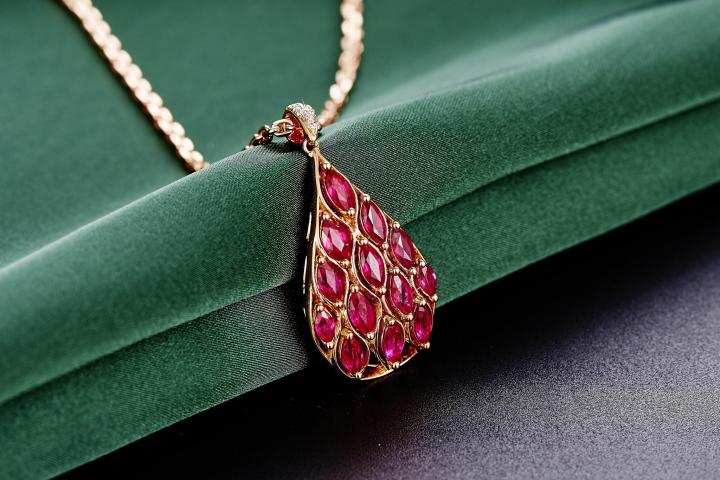
July Birthstone
The July birthstone is the ruby, which is believed to protect its wearer from evil.
Find our more about July’s birthstone.
July Zodiac & Astrology
July’s zodiac signs are Cancer (June 21 to July 22) and Leo (July 23 to August 22). Find out your zodiac sign profile.
Mercury Retrograde: Mercury will enter retrograde motion on July 7, finishing on August 2. Read more about Mercury Retrograde.
This Month in History
WE DO DECLARE!
On April 19, 1775, during the Battles of Lexington and Concord (Mass.), the first shots were fired between colonists and British troops, starting the American Revolution. After these first military conflicts, tension between Britain and her American colonists continued to mount. Finally, on July 2, 1776, the Second Continental Congress voted for independence from Britain.
Two days later, on July 4, the Congress approved the final draft of the Declaration of Independence, which had been written by Thomas Jefferson and edited by John Adams and Benjamin Franklin. On July 8, the first public reading of the Declaration took place at the Pennsylvania State House (now Independence Hall) in Philadelphia, Pennsylvania. Later that same day, other readings occurred in Trenton, New Jersey, and Easton, Pennsylvania.
Printer John Dunlap made about 200 copies of the Declaration dated July 4. Known as the (continued on next page) “Dunlap Broadsides,” these were distributed throughout the 13 colonies. However, it wasn’t until August 2 that the Declaration was officially signed. John Hancock, president of the Congress, was the first of 56 delegates who signed this enlarged version, writing in big, bold letters.
06-30-2019 05:42 PM
The Folklore Year – July by Ben Johnson
The photo below is from the Mystery Plays at Chester Cathedral, a set of plays first enacted by medieval craftsmen and guildsmen in the 14th century. Nowadays they take place in early July every five years!
Readers should always check with local Tourist Information Centres (TIC’s) that events or festivals are actually taking place before setting out to attend.
Permanent dates in July| 15th July | St Swithin’s Day | According to an ancient tradition, if it rains on St Swithin’s Day, it will rain for the next 40 days. The story began in the year 971, when the bones of St Swithin (who had died over 100 years before) were moved to a special shrine at Winchester Cathedral, and there was a terrific storm that lasted for 40 days. People said that the saint in heaven was weeping because his bones had been moved. | |
| 19th July | Little Edith’s Treat | Piddinghoe, Sussex | Children at Piddinghoe enjoy a special tea and sports on this day. The custom began in 1868, when a baby called Edith Croft died. Edith’s grandmother put up the money for a treat for the village children in Edith’s memory. |
| 20th July | St Margaret’s Day | Gloucestershire | St Margaret was once a very popular saint – she had the nick name of St Peg. People believed that doing honour to Peg would bring them God’s protection against illnesses and evil spirits. St Peg’s day was traditionally celebrated with a plum pudding called Heg Peg Dump. |
| 25th July | Ebernoe Horn Fair | Ebernoe, Sussex | A ram is roasted and a cricket match is played between Ebernoe and a nearby village. The ram’s horns are presented to the batsman who makes the most runs. |
| 31st July | Start of oyster season | It is said that if you eat oysters today, you’ll have plenty of money during the year to come. |
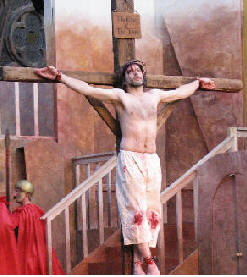
With kind permission & courtesy of Chester Mystery Plays
Flexible dates in July| Various dates in July, checkout the details of these events at the Morris Ring website | Morris Dancing | At various locations | Regarded as an ancient tradition even in the reign of Elizabeth I, these ‘madde men’ with their ‘Devils dance’ were banned by the Puritans following the Civil War. |
| During the month | Well Dressing | At various locations in Derbyshire including; Bradlow, Buxton, Pilsley, West Hallam and Whitewell. | |
| Date depends upon the tides | Doggett’s Coat and Badge Race. | River Thames, from London Bridge to Cadogan Pier | Thomas Doggett, an Irish actor and comedian, came to London around 1690. He eventually became manager of the Haymarket Theatre. Doggett initiated the race in 1715 between the Watermen of the Thames, who were then the equivalent of the modern taxi drivers. Watermen were licensed to row passengers along and across the River Thames. A staunch Whig, Doggett funded the race to commemorate the accession to the throne of George I. Newly qualified Thames Watermen now race for the much prized Coat and Badge. |
| First Thursday after the 4th | Vintners’ Procession | City of London | Members of the Worshipful Company of Vintners (wine merchants) march through the City. At the front of the procession, two men in white smocks and top hats sweep the street with twig-brooms. The custom began in the days when London’s streets were covered with foul-smelling dirt, and the vintners did not want to slip in the mess! |
| Early in the month | International Music Eisteddfod | Llangollen, Wales | The National Eisteddfod of Wales is said to date back to 1176, when Lord Rhys invited poets and musicians from all over Wales to a grand gathering at his castle in Cardigan. A chair at the Lord’s table was awarded to the best poet and musician, a tradition that continues today in the modern Eisteddfod. Details of which can be found here. |
| First Saturday of the month | Rush-bearing | Great Musgrave and Ambleside, Cumbria | In the Middle Ages, before carpets, rushes were used as floor-covering. Many villages held a special summer ceremony when the rushes were harvested. In some villages, they made rush sculptures, called bearings, and carried these in a procession. Rush-bearings are still popular in Cumbria and other parts of north-west England |
| First Sunday of the month | Midsummer Bonfire | Whalton, Northumberland | Originally held on the old Midsummer’s Eve (4 July) and called the Whalton Bale. It refers to a great fire built on the green, “bale” being the Saxon word for fire. The accompanying festivities included Morris Men, sword dancing. fiddlers and pipers. |
| Early in the month, every five years, next in 2018 | Chester Mystery Plays | Chester Cathedral, Cheshire | The original texts represent the most complete of the few surviving English mystery plays. This famous series of dramatic stories drawn from the Bible, include the life of Christ from birth to crucifixion and resurrection. The plays were first enacted by medieval craftsmen and guildsmen in 14th century Chester. In modern times the plays were revived in 1951. For more details visit www.chestermysteryplays.com |
| July every Leap Year | Dunmow Flitch | Great Dunmow, Essex | Couples convinced they can live in married bliss are invited to participate in the annual Dunmow Flitch Trials. This ancient folk ceremony takes place every four years. In the trials, married couples have to convince a jury that ‘in 12 month and a day’ they have ‘not wished themselves unmarried again’. Couples who satisfy the six maidens and a six bachelors of Dunmow, walk away with the ‘flitch’ – a side of bacon. Locals parade the victors shoulder-high through the streets. Legend claims that the trials date back to 1104, when the then lord of the manor, Reginald Fitzwalter, and his wife dressed themselves as paupers and begged for the Prior’s blessing one year after their wedding. So touched was the Prior by the couple’s display of devotion, that he presented them with a flitch of bacon. The Lord then unveiled his true identity and promised land to the priory on condition that any couple, who could display such devotion, should be similarly rewarded. It appears that by the middle of the fourteenth century the trials had become famous; in 1362, the poet William Langland referred to the trials in ‘Piers the Plowman’, and Chaucer mentions them in the Wife of Bath’s Tale. Now seven hundred years later thousands still flock to Dunmow to celebrate this tradition. The saying ‘to bring home the bacon’, meaning to prove your worth, is thought to have derived from these trials. For further information and the opportunity to stand trial visit www.dunmowflitchtrials.co.uk |
| Mid-month | Signor Pasquale Favale’s Bequest | Guildhall, City of London | Signor Pasquale Favale was an Italian who lived in the City of London. On his death in 1882 he bequeathed 18,000 Italian lira to the Corporation of London to provide marriage dowries to help ‘poor, honest and young’ women set up home. In his will it stated that he had been ‘induced to make this bequest by the fact that his wife was a native of London and that he had passed many happy years of his life in that City.’ Over 100 years later the sum given to eligible brides is now worth £100. To be considered for the dowry, applicants need to have been born or have lived within the City of London boundaries. |
| Third week of the month | Swan Upping | River Thames, between Sunbury and Pangbourne | Two of the oldest London Guilds, the wine merchants and the Dyers, take to their boats to try to catch the swans on the Thames. All the swans on the river belong to the queen, except for those marked on their beaks, which belong to the Dyers and Vintners. “Upping” means turning the bird’s upside-down, to establish ownership of the cygnets by inspecting their parents. After swan-upping, the Dyers and Vintners settle down to a banquet of roast swan. The custom dates back to the 14th century. |
| First Thursday after the 25th | Blessing of the Boats | Whitstable, Kent | The start of oyster season is celebrated with the blessing of the fishing boats on St. Reeves’ Beach – an event dating back to at least the early 19th century. The history of Whitstable’s oysters, which the Romans consumed in huge quantities, is told in the local history museum on the High Street. www.whitstable-museum.co.uk |
We have taken great care in recording and detailing the festivals, customs and celebrations presented in our Folklore Year calendar, if however you consider that we have omitted any significant local event, we would be delighted to hear from you.
06-30-2019 05:45 PM
July Weather Lore
July is a month with some good weather lore. First, July 3rd marks the beginning of the “Dog Days of Summer,” the period between July 3rd and August 11th when the Sun occupies the same region of the sky as Sirius, the Dog Star. It was once believed that due to the star’s position at this time of year that it somehow conspired with the Sun to make the days hotter. Many people also believed that the hot days of the summer caused dogs to go mad, thus the name.
Other July weather lore:
July 15 — St. Swithin Day — if on St. Swithin’s Day ye do rain, for forty days it will remain.
July 25 — Puffy white clouds on this day foretells much snow in the coming winter.
July 26 — St. Anne’s day — Rain on St. Anne’s will continue for a month and a week.
Have you heard any of these?
If the sky beyond the clouds is blue,
Be glad, there is a picnic for you.
When wind comes before rain,
Soon you may make sail again.
For I fear a hurricane;
Last night the moon had a golden ring,
And tonight no moon we see.
When the moon is in the north,
The skillful fisher goes not forth;
When the wind is in the east,
‘Tis good for neither man nor beast;
When the wind is in the south,
It blows the flies in the fish’s Mouth;
But when the win is in the west,
There is it the very best.
Farmer’s crop lore: Corn should be
Knee high by the 4th of July
Know any other weather lore sayings associated with July? Share them with us here.
06-30-2019 05:49 PM
06-30-2019 05:53 PM - edited 06-30-2019 05:54 PM
06-30-2019 05:56 PM
"Yankee Doodle" is a well-known American song, the early versions of which date to before the Seven Years' War and the American Revolution.[1] It is often sung patriotically in the United States today and is the state anthem of Connecticut.[2] Its Roud Folk Song Index number is 4501. The melody is thought to be much older than both the lyrics and the subject, going back to folk songs of Medieval Europe.[3][4]
Origin
The tune of Yankee Doodle is thought to be much older than the lyrics, being well known across western Europe, including England, France, Holland, Hungary, and Spain.[3] The earliest words of "Yankee Doodle" came from a Middle Dutch harvest song which is thought to have followed the same tune, possibly dating back as far as 15th-century Holland.[5][6] It contained mostly nonsensical words in English and Dutch: "Yanker, didel, doodle down, Diddle, dudel, lanther, Yanke viver, voover vown, Botermilk und tanther."[3][4][6] Farm laborers in Holland were paid "as much buttermilk (Botermilk) as they could drink, and a tenth (tanther) of the grain".[4][6]
The term Doodle first appeared in English in the early seventeenth century[7] and is thought to be derived from the Low German dudel, meaning "playing music badly", or Dödel, meaning "fool" or "simpleton". The Macaroni wig was an extreme fashion in the 1770s and became slang for being a fop.[8] Dandies were men who placed particular importance upon physical appearance, refined language, and leisure hobbies. A self-made dandy was a British middle-class man who impersonated an aristocratic lifestyle. They notably wore silk strip cloth, stuck feathers in their hats, and carried two pocket watches with chains—"one to tell what time it was and the other to tell what time it was not".[9]
The macaroni wig was an example of such Rococo dandy fashion, popular in elite circles in Western Europe and much mocked in the London press. The term macaroni was used to describe a fashionable man who dressed and spoke in an outlandishly affected and effeminate manner. The term pejoratively referred to a man who "exceeded the ordinary bounds of fashion"[10] in terms of clothes, fastidious eating, and gambling.
In British conversation, the term "Yankee doodle dandy" implied unsophisticated misappropriation of high-class fashion, as though simply sticking a feather in one's cap would make one to be noble.[11] Peter McNeil, professor of fashion studies, claims that the British were insinuating that the colonists were low-class men lacking masculinity, emphasizing that the American men were womanly.[12]
Early versions
The song was a pre-Revolutionary War song originally sung by British military officers to mock the disheveled, disorganized colonial "Yankees" with whom they served in the French and Indian War. It was written around 1755 by British Army surgeon Dr. Richard Shuckburgh while campaigning in upper New York,[13] and the British troops sang it to make fun of their stereotype of the American soldier as a Yankee simpleton who thought that he was stylish if he simply stuck a feather in his cap.[1] It was also popular among the Americans as a song of defiance,[1] and they added additional verses to it that mocked the British troops and hailed George Washington as the Commander of the Continental army. By 1781, Yankee Doodle had turned from being an insult to being a song of national pride.[14][15]
According to one account, Shuckburgh wrote the original lyrics after seeing the appearance of Colonial troops under Colonel Thomas Fitch, the son of Connecticut Governor Thomas Fitch.[16] According to Etymology Online, "the current version seems to have been written in 1776 by Edward Bangs, a Harvard sophomore who also was a Minuteman."[13] He wrote a ballad with 15 verses which circulated in Boston and surrounding towns in 1775 or 1776.[17]
A bill was introduced to the House of Representatives on July 25, 1999[18] recognizing Billerica, Massachusetts as "America's Yankee Doodle Town". After the Battle of Lexington and Concord, a Boston newspaper reported:
Upon their return to Boston [pursued by the Minutemen], one [Briton] asked his brother officer how he liked the tune now, — "Dang them", returned he, "they made us dance it till we were tired" — since which Yankee Doodle sounds less sweet to their ears.
The earliest known version of the lyrics comes from 1755 or 1758, as the date of origin is disputed:[19]
Brother Ephraim sold his Cow
And bought him a Commission;
And then he went to Canada
To fight for the Nation;
But when Ephraim he came home
He proved an arrant Coward,
He wouldn't fight the Frenchmen there
For fear of being devoured.
The sheet music which accompanies these lyrics reads, "The Words to be Sung through the Nose, & in the West Country drawl & dialect." The tune also appeared in 1762 in one of America's first comic operas The Disappointment, with bawdy lyrics about the search for Blackbeard's buried treasure by a team from Philadelphia.[20] An alternate verse that the British are said to have marched to is attributed to an incident involving Thomas Ditson of Billerica, Massachusetts.[21] British soldiers tarred and feathered Ditson because he attempted to buy a musket in Boston in March 1775; he evidently secured one eventually, because he fought at Concord.[22] For this reason, the town of Billerica is called the home of Yankee Doodle:[23][24]
Yankee Doodle came to town,
For to buy a firelock,
We will tar and feather him,
And so we will John Hancock.
Another pro-British set of lyrics believed to have used the tune was published in June 1775 following the Battle of Bunker Hill:[25]
The seventeen of June, at Break of Day,
The Rebels they supriz'd us,
With their strong Works, which they'd thrown up,
To burn the Town and drive us.
Yankee Doodle was played at the British surrender at Saratoga in 1777.[26] A variant is preserved in the 1810 edition of Gammer Gurton's Garland: Or, The Nursery Parnassus, collected by Francis Douce:
Yankey Doodle came to town,
How do you think they serv'd him?
One took his bag, another his scrip,
The quicker for to starve him.[27]
Full version
The Spirit of '76 (aka Yankee Doodle)ArtistYearTypeDimensionsLocation
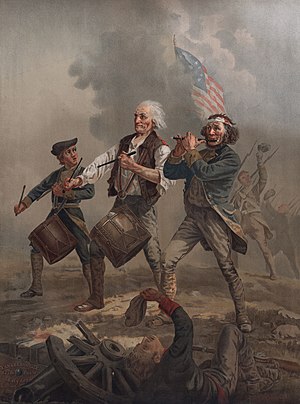 |
| Archibald MacNeal Willard |
| circa 1875 |
| oil |
| 61 cm × 45 cm (24 in × 18 in) |
| United States Department of State |
The full version of the song, as it is known today, goes:[28][29]
Yankee Doodle went to town
A-riding on a pony,
Stuck a feather in his cap
And called it macaroni.
[Chorus]
Yankee Doodle keep it up,
Yankee Doodle dandy,
Mind the music and the step,
And with the girls be handy.
Father and I went down to camp,
Along with Captain Gooding,
And there we saw the men and boys
As thick as hasty pudding.
[Chorus]
And there we saw a thousand men
As rich as Squire David,
And what they wasted every day,
I wish it could be savèd.
[Chorus]
The 'lasses they eat every day,
Would keep a house a winter;
They have so much, that I'll be bound,
They eat it when they've a mind to.
[Chorus]
And there I see a swamping[a] gun
Large as a log of maple,
Upon a deuced little cart,
A load for father's cattle.
[Chorus]
And every time they shoot it off,
It takes a horn of powder,
And makes a noise like father's gun,
Only a nation[b] louder.
[Chorus]
I went as nigh to one myself
As 'Siah's underpinning;
And father went as nigh again,
I thought the deuce was in him.
[Chorus]
Cousin Simon grew so bold,
I thought he would have cocked it;
It scared me so I shrinked it off
And hung by father's pocket.
[Chorus]
And Cap'n Davis had a gun,
He kind of clapt his hand on't
And stuck a crooked stabbing iron
Upon the little end on't
[Chorus]
And there I see a pumpkin shell
As big as mother's basin,
And every time they touched it off
They scampered like the nation.
[Chorus]
I see a little barrel too,
The heads were made of leather;
They knocked on it with little clubs
And called the folks together.
[Chorus]
And there was Cap'n Washington,
And gentle folks about him;
They say he's grown so 'tarnal proud
He will not ride without 'em.
[Chorus]
He got him on his meeting clothes,
Upon a slapping stallion;
He sat the world along in rows,
In hundreds and in millions.
[Chorus]
The flaming ribbons in his hat,
They looked so tearing fine, ah,
I wanted dreadfully to get
To give to my Jemima.
[Chorus]
I see another snarl of men
A-digging graves, they told me,
So 'tarnal long, so 'tarnal deep,
They 'tended they should hold me.
[Chorus]
It scared me so, I hooked it off,
Nor stopped, as I remember,
Nor turned about till I got home,
Locked up in mother's chamber.
[Chorus]
06-30-2019 06:00 PM
"The serene philosophy of the pink rose is steadying. Its fragrant, delicate petals open fully and are ready to fall, without regret or disillusion, after only a day in the sun. It is so every summer. One can almost hear their pink, fragrant murmur as they settle down upon the grass: 'Summer, summer, it will always be summer.'"
- Rachel Peden
"Tis now the summer of your youth: time has not cropped the roses from your cheek, though sorrow long has washed them."
- Edward Moore
"The Summer looks out from her brazen tower,
Through the flashing bars of July."
- Francis Thompson, A Corymbus for Autumn
"Mosquito is out,
it's the end of the day;
she's humming and hunting
her evening away.
Who knows why such hunger
arrives on such wings
at sundown? I guess
it's the nature of things."
- N. M. Boedecker, Midsummer Night Itch
"For him in vain the envious seasons roll
Who bears eternal summer in his soul."
- Oliver Wendell Holmes, The Old Player
"He stood beside a cottage lone
And listened to a lute,
One summer's eve, when the breeze was gone,
And the nightingale was mute."
- Thomas K. Hervey, The Devil's Progress
"No bought potpourri is so pleasant as that made from ones own garden, for the petals of the flowers one has gathered at home hold the sunshine and memories of summer, and of past summers only the sunny days should be remembered."
- Eleanor Sinclair-Rhode
"Summer is the time when one sheds one's tensions with one's clothes, and the right kind of day is jeweled balm for the battered spirit. A few of those days and you can become drunk with the belief that all's right with the world."
- Ada Louise Huxtable
"Many public-school children seem to know only two dates: 1492 and 4th of July; and as a rule they don't know what happened on either occasion."
- Mark Twain
"Answer July—
Where is the Bee—
Where is the Blush—
Where is the Hay?
Ah, said July—
Where is the Seed—
Where is the Bud—
Where is the May—
Answer Thee—Me—"
- Emily Dickinson, Answer July
"Do what we can, summer will have its flies."
- Ralph Waldo Emerson
"Hot July brings cooling showers,
Apricots and gillyflowers."
- Sara Coleridge, Pretty Lessons in Verse
06-30-2019 06:03 PM
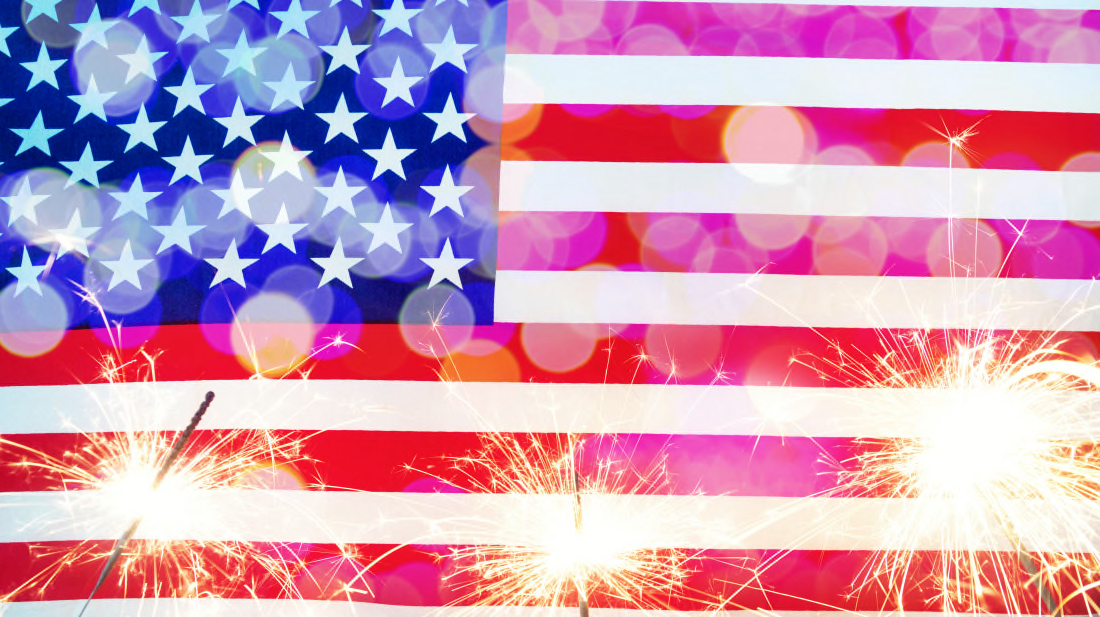
With 243 years of tradition behind it, the Fourth of July is one of America's most cherished holidays. It's when we celebrate our nation's mythology with a day off, a backyard barbecue, and plenty of fireworks. But with all that history, you'd be forgiven if you didn't know quite everything about July 4. So from the true story behind the signing of the Declaration of Independence, to some staggering hot dog statistics, here are 10 things you might not know about the Fourth of July.
1. The Declaration of Independence wasn't signed on July 4 (or in July at all).
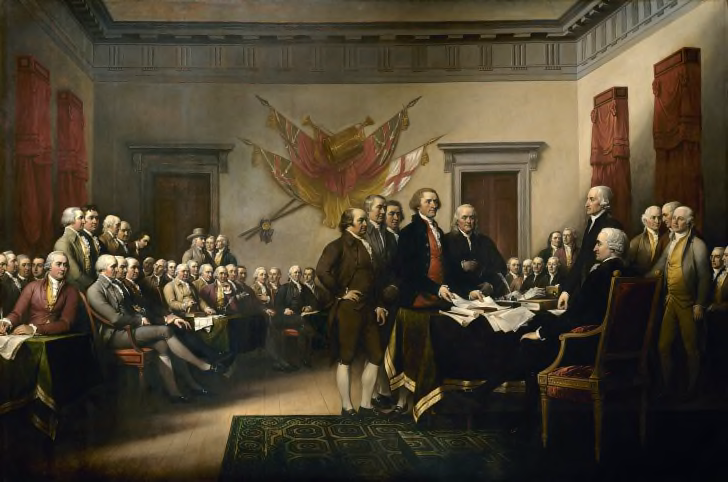
It might make for an iconic painting, but that famous image of all the Founding Fathers and Continental Congress huddled together, presenting the first draft of the Declaration of Independence for July 4, 1776 signing, isn't quite how things really went down. As famed historian David McCullough wrote, "No such scene, with all the delegates present, ever occurred at Philadelphia."
It's now generally accepted that the Declaration of Independence wasn't signed on the Fourth of July—that's just the day the document was formally dated, finalized, and adopted by the Continental Congress, which had officially voted for independence on July 2 (the day John Adams thought we should celebrate). Early printed copies of the Declaration were signed by John Hancock and secretary Charles Thomson to be given to military officers and various political committees, but the bulk of the other 54 men signed an official engrossed (finalized and in larger print) copy on August 2, with others to follow at a later date. Hancock (boldly) signed his name again on the updated version.
So if you want to sound like a history buff at your family's barbecue this year, point out that we're celebrating the adoption of the Declaration, not the signing of it.
2. The first celebrations weren't much different than today's.After years of pent-up frustration, the colonies let loose upon hearing the words of the Declaration of Independence in 1776. Military personnel and civilians in the Bowling Green section of Manhattan tore down a statue of King George III and later melted it into bullets; the King's coat of arms was used as kindling for a bonfire in Philadelphia; and in Savannah, Georgia, the citizens burnt the King in effigy and held a mock funeral for their royal foe.
Independence Day celebrations began to look a bit more familiar the following year, as the July 18, 1777 issue of the Virginia Gazette describes the July 4 celebration in Philadelphia:
"The evening was closed with the ringing of bells, and at night there was a grand exhibition of fireworks, which began and concluded with thirteen rockets on the commons, and the city was beautifully illuminated. Every thing was conducted with the greatest order and decorum, and the face of joy and gladness was universal."
There were even ships decked out in patriotic colors lining harbors and streamers littering city streets. Once you get past the mock funerals and rioting of 1776, modern Independence Day celebrations have stuck pretty close to the traditions started in 1777.
3. Eating salmon on the Fourth of July is a tradition in New England.The tradition of eating salmon on the Fourth of July began in New England as kind of a coincidence. It just so happened that during the middle of the summer, salmon was in abundance in rivers throughout the region, so it was a common sight on tables at the time. It eventually got lumped in to the Fourth and has stayed that way ever since, even with the decline of Atlantic salmon.
To serve salmon the traditional New England way, you'll have to pair it with some green peas. And if you're really striving for 18th-century authenticity, enjoy the whole meal with some turtle soup, like John and Abigail Adams supposedly did on the first Fourth of July. (You can still be a patriot without the soup, though.)
4. Massachusetts was the first state to recognize the holiday.Massachusetts recognized the Fourth of July as an official holiday on July 3, 1781, making it the first state to do so. It wasn't until June 28, 1870 that Congress decided to start designating federal holidays [PDF], with the first four being New Year's Day, Independence Day, Thanksgiving, and Christmas. This decreed that those days were holidays for federal employees.
However, there was a distinction. The Fourth was a holiday "within the District of Columbia" only. It would take years of new legislation to expand the holiday to all federal employees.
5. The oldest annual Fourth of July Celebration is held in Bristol, Rhode Island.Eighty-five years before the Fourth of July was even recognized as a federal holiday, one tradition began that continues to this day. Billed as "America's Oldest Fourth of July Celebration," the town of Bristol, Rhode Island, has been doing Independence Day right since 1785.
The festivities began just two years after the Revolutionary War ended, and 2019 will be its 234th entry. Over the years the whole thing has expanded well beyond July 4; the town of 23,000 residents now begins to celebrate the United States on Flag Day, June 14, all the way through to the 2.5-mile July 4 parade. What began as a "patriotic exercise"—meaning church services—has morphed into a cavalcade of parades, live music, food, and other activities.
6. The shortest Fourth of July parade is in Aptos, California.From the oldest to the shortest, the Fourth of July parade in Aptos, California, is just a hair over half a mile long. Taking up two city blocks, and measuring just .6 miles, this brief bit of patriotism features antique cars, decorated trucks, and plenty of walkers. Afterward, there's a Party in the Park, where folks can enjoy live music, food, and games.
7. There are around 15,000 Independence Day fireworks celebrations every year.
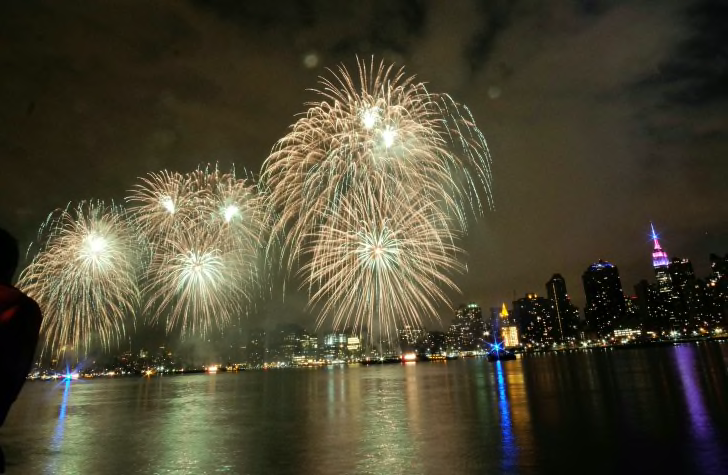
According to the American Pyrotechnics Association, around 15,000 fireworks displays will take place for the Fourth of July holiday (even if some aren't exactly on July 4). Though pricing varies, most small towns spend anywhere from $8000-$15,000 for a fireworks display, with larger cities going into the millions, like the Boston Pops Fireworks Spectacular that averages more than $2 million.
8. We'll eat an obscene amount of hot dogs.Around 150 million, to be more specific—that's how many hot dogs will be consumed by Americans on the Fourth of July. According to the National Hot Dog and Sausage Council, that amount of dogs can stretch from Washington D.C. to Los Angeles more than five times.
In 2018, 74 of those dogs were scarfed down by Joey Chestnut, who won the annual Nathan's Hot Dog Eating Competition for the eleventh time.
9. And we'll spend billions on food.Americans will spend big on food and drinks this Fourth. Big to the tune of around $6.7 billion when all is said and done, according to the National Retail Federation. This includes food and other cookout expenses, averaging out to about $73 per person participating in a barbecue, outdoor cookout or picnic.
Then comes the booze. According to the Beer Institute, "more beer is sold on and around the Fourth of July holiday than during any other time throughout the year." Generally, Americans will spend around $1 billion on beer for their Fourth celebrations, and more than $560 million on wine.
10. Three presidents have died, and one was born, on the Fourth of July.You probably know that both Thomas Jefferson and John Adams died on July 4, 1826—50 years to the day after the Declaration of Independence was adopted. They're not the only presidents to have died on the Fourth, though; James Monroe—the nation's fifth president—died just a few years later on July 4, 1831.
Though the holiday might seem like it has it out for former presidents, there was one future leader born on Independence Day. The country's 30th Commander-in-Chief, Calvin Coolidge, was born on July 4, 1872.
06-30-2019 06:09 PM - edited 06-30-2019 06:23 PM
Our Lives, Our Fortunes, Our Sacred Honor”
It was a glorious morning. The sun was shining and the wind was from the Southeast. Up especially early, a tall bony, redheaded young Virginian found time to buy a new thermometer, for which he paid three pounds, fifteen shillings. He also bought gloves for Martha, his wife, who was ill at home.
Thomas Jefferson arrived early at the statehouse. The temperature was 72.5 degrees and the horseflies weren’t nearly so bad at that hour. It was a lovely room, very large, with gleaming white walls. The chairs were comfortable. Facing the single door were two brass fireplaces, but they would not be used today.
The moment the door was shut, and it was always kept locked, the room became an oven. The tall windows were shut, so that loud quarreling voices could not be heard by passersby. Small openings atop the windows allowed a slight stir of air, and also a large number of horseflies. Jefferson records that “the horseflies were dexterous in finding necks, and the silk of stockings was nothing to them.” All discussing was punctuated by the slap of hands on necks.
On the wall at the back, facing the president’s desk, was a panoply — consisting of a drum, swords, and banners seized from Fort Ticonderoga the previous year. Ethan Allen and Benedict Arnold had captured the place, shouting that they were taking it “in the name of the Great Jehovah and the Continental Congress!”
Now Congress got to work, promptly taking up an emergency measure about which there was discussion but no dissension. “Resolved: That an application be made to the Committee of Safety of Pennsylvania for a supply of flints for the troops at New York.”
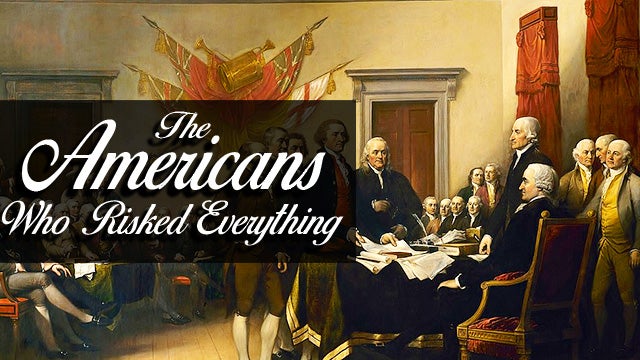 Then Congress transformed itself into a committee of the whole. The Declaration of Independence was read aloud once more, and debate resumed. Though Jefferson was the best writer of all of them, he had been somewhat verbose. Congress hacked the excess away. They did a good job, as a side-by-side comparison of the rough draft and the final text shows. They cut the phrase “by a self-assumed power.” “Climb” was replaced by “must read,” then “must” was eliminated, then the whole sentence, and soon the whole paragraph was cut. Jefferson groaned as they continued what he later called “their depredations.” “Inherent and inalienable rights” came out “certain unalienable rights,” and to this day no one knows who suggested the elegant change.
Then Congress transformed itself into a committee of the whole. The Declaration of Independence was read aloud once more, and debate resumed. Though Jefferson was the best writer of all of them, he had been somewhat verbose. Congress hacked the excess away. They did a good job, as a side-by-side comparison of the rough draft and the final text shows. They cut the phrase “by a self-assumed power.” “Climb” was replaced by “must read,” then “must” was eliminated, then the whole sentence, and soon the whole paragraph was cut. Jefferson groaned as they continued what he later called “their depredations.” “Inherent and inalienable rights” came out “certain unalienable rights,” and to this day no one knows who suggested the elegant change.
A total of 86 alterations were made. Almost 500 words were eliminated, leaving 1,337. At last, after three days of wrangling, the document was put to a vote.
Here in this hall Patrick Henry had once thundered: “I am no longer a Virginian, sir, but an American.” But today the loud, sometimes bitter argument stilled, and without fanfare the vote was taken from north to south by colonies, as was the custom. On July 4, 1776, the Declaration of Independence was adopted.
There were no trumpets blown. No one stood on his chair and cheered. The afternoon was waning and Congress had no thought of delaying the full calendar of routine business on its hands. For several hours they worked on many other problems before adjourning for the day.
Much To Lose
What kind of men were the 56 signers who adopted the Declaration of Independence and who, by their signing, committed an act of treason against the crown? To each of you, the names Franklin, Adams, Hancock and Jefferson are almost as familiar as household words. Most of us, however, know nothing of the other signers. Who were they? What happened to them?
I imagine that many of you are somewhat surprised at the names not there: George Washington, Alexander Hamilton, Patrick Henry. All were elsewhere.
Ben Franklin was the only really old man. Eighteen were under 40; three were in their 20s. Of the 56 almost half – 24 – were judges and lawyers. Eleven were merchants, nine were landowners and farmers, and the remaining 12 were doctors, ministers, and politicians.
With only a few exceptions, such as Samuel Adams of Massachusetts, these were men of substantial property. All but two had families. The vast majority were men of education and standing in their communities. They had economic security as few men had in the 18th Century.
Each had more to lose from revolution than he had to gain by it. John Hancock, one of the richest men in America, already had a price of 500 pounds on his head. He signed in enormous letters so that his Majesty could now read his name without glasses and could now double the reward. Ben Franklin wryly noted: “Indeed we must all hang together, otherwise we shall most assuredly hang separately.”
Fat Benjamin Harrison of Virginia told tiny Elbridge Gerry of Massachusetts: “With me it will all be over in a minute, but you, you will be dancing on air an hour after I am gone.”
These men knew what they risked. The penalty for treason was death by hanging. And remember, a great British fleet was already at anchor in New York Harbor.
 They were sober men. There were no dreamy-eyed intellectuals or draft card burners here. They were far from hot-eyed fanatics yammering for an explosion. They simply asked for the status quo. It was change they resisted. It was equality with the mother country they desired. It was taxation with representation they sought. They were all conservatives, yet they rebelled.
They were sober men. There were no dreamy-eyed intellectuals or draft card burners here. They were far from hot-eyed fanatics yammering for an explosion. They simply asked for the status quo. It was change they resisted. It was equality with the mother country they desired. It was taxation with representation they sought. They were all conservatives, yet they rebelled.
It was principle, not property, that had brought these men to Philadelphia. Two of them became presidents of the United States. Seven of them became state governors. One died in office as vice president of the United States. Several would go on to be US Senators. One, the richest man in America, in 1828 founded the Baltimore and Ohio Railroad. One, a delegate from Philadelphia, was the only real poet, musician and philosopher of the signers. (It was he, Francis Hopkinson not Betsy Ross who designed the United States flag.)
Richard Henry Lee, a delegate from Virginia, had introduced the resolution to adopt the Declaration of Independence in June of 1776. He was prophetic in his concluding remarks: “Why then sir, why do we longer delay? Why still deliberate? Let this happy day give birth to an American Republic. Let her arise not to devastate and to conquer but to reestablish the reign of peace and law.
“The eyes of Europe are fixed upon us. She demands of us a living example of freedom that may exhibit a contrast in the felicity of the citizen to the ever-increasing tyranny which desolates her polluted shores. She invites us to prepare an asylum where the unhappy may find solace, and the persecuted repost.
“If we are not this day wanting in our duty, the names of the American Legislatures of 1776 will be placed by posterity at the side of all of those whose memory has been and ever will be dear to virtuous men and good citizens.”
Though the resolution was formally adopted July 4, it was not until July 8 that two of the states authorized their delegates to sign, and it was not until August 2 that the signers met at Philadelphia to actually put their names to the Declaration.
William Ellery, delegate from Rhode Island, was curious to see the signers’ faces as they committed this supreme act of personal courage. He saw some men sign quickly, “but in no face was he able to discern real fear.” Stephan Hopkins, Ellery’s colleague from Rhode Island, was a man past 60. As he signed with a shaking pen, he declared: “My hand trembles, but my heart does not.”
“Most Glorious Service”
Even before the list was published, the British marked down every member of Congress suspected of having put his name to treason. All of them became the objects of vicious manhunts. Some were taken. Some, like Jefferson, had narrow escapes. All who had property or families near British strongholds suffered.
Francis Lewis, New York delegate saw his home plundered — and his estates in what is now Harlem — completely destroyed by British Soldiers. Mrs. Lewis was captured and treated with great brutality. Though she was later exchanged for two British prisoners through the efforts of Congress, she died from the effects of her abuse.
William Floyd, another New York delegate, was able to escape with his wife and children across Long Island Sound to Connecticut, where they lived as refugees without income for seven years. When they came home they found a devastated ruin.
Philips Livingstone had all his great holdings in New York confiscated and his family driven out of their home. Livingstone died in 1778 still working in Congress for the cause.
Louis Morris, the fourth New York delegate, saw all his timber, crops, and livestock taken. For seven years he was barred from his home and family.
John Hart of Trenton, New Jersey, risked his life to return home to see his dying wife. Hessian soldiers rode after him, and he escaped in the woods. While his wife lay on her deathbed, the soldiers ruined his farm and wrecked his homestead. Hart, 65, slept in caves and woods as he was hunted across the countryside. When at long last, emaciated by hardship, he was able to sneak home, he found his wife had already been buried, and his 13 children taken away. He never saw them again. He died a broken man in 1779, without ever finding his family.
Dr. John Witherspoon, signer, was president of the College of New Jersey, later called Princeton. The British occupied the town of Princeton, and billeted troops in the college. They trampled and burned the finest college library in the country.
Judge Richard Stockton, another New Jersey delegate signer, had rushed back to his estate in an effort to evacuate his wife and children. The family found refuge with friends, but a Tory sympathizer betrayed them. Judge Stockton was pulled from bed in the night and brutally beaten by the arresting soldiers. Thrown into a common jail, he was deliberately starved. Congress finally arranged for Stockton’s parole, but his health was ruined. The judge was released as an invalid, when he could no longer harm the British cause.
He returned home to find his estate looted and did not live to see the triumph of the Revolution. His family was forced to live off charity.
Robert Morris, merchant prince of Philadelphia, delegate and signer, met Washington’s appeals and pleas for money year after year. He made and raised arms and provisions which made it possible for Washington to cross the Delaware at Trenton. In the process he lost 150 ships at sea, bleeding his own fortune and credit almost dry.
George Clymer, Pennsylvania signer, escaped with his family from their home, but their property was completely destroyed by the British in the Germantown and Brandywine campaigns.
Dr. Benjamin Rush, also from Pennsylvania, was forced to flee to Maryland. As a heroic surgeon with the army, Rush had several narrow escapes.
John Martin, a Tory in his views previous to the debate, lived in a strongly loyalist area of Pennsylvania. When he came out for independence, most of his neighbors and even some of his relatives ostracized him. He was a sensitive and troubled man, and many believed this action killed him. When he died in 1777, his last words to his tormentors were: “Tell them that they will live to see the hour when they shall acknowledge it [the signing] to have been the most glorious service that I have ever rendered to my country.”
William Ellery, Rhode Island delegate, saw his property and home burned to the ground.
Thomas Lynch, Jr., South Carolina delegate, had his health broken from privation and exposures while serving as a company commander in the military. His doctors ordered him to seek a cure in the West Indies and on the voyage, he and his young bride were drowned at sea.
Edward Rutledge, Arthur Middleton, and Thomas Heyward, Jr., the other three South Carolina signers, were taken by the British in the siege of Charleston. They were carried as prisoners of war to St. Augustine, Florida, where they were singled out for indignities. They were exchanged at the end of the war, the British in the meantime having completely devastated their large landholdings and estates.
Thomas Nelson, signer of Virginia, was at the front in command of the Virginia military forces. With British General Charles Cornwallis in Yorktown, fire from 70 heavy American guns began to destroy Yorktown piece by piece. Lord Cornwallis and his staff moved their headquarters into Nelson’s palatial home. While American cannonballs were making a shambles of the town, the house of Governor Nelson remained untouched. Nelson turned in rage to the American gunners and asked, “Why do you spare my home?”
They replied, “Sir, out of respect to you.” Nelson cried, “Give me the cannon!” and fired on his magnificent home himself, smashing it to bits. But Nelson’s sacrifice was not quite over. He had raised $2 million for the Revolutionary cause by pledging his own estates. When the loans came due, a newer peacetime Congress refused to honor them, and Nelson’s property was forfeited. He was never reimbursed. He died, impoverished, a few years later at the age of 50.
Lives, Fortunes, Honor
Of those 56 who signed the Declaration of Independence, nine died of wounds or hardships during the war. Five were captured and imprisoned, in each case with brutal treatment. Several lost wives, sons or entire families. One lost his 13 children. Two wives were brutally treated. All were at one time or another the victims of manhunts and driven from their homes. Twelve signers had their homes completely burned. Seventeen lost everything they owned. Yet not one defected or went back on his pledged word. Their honor, and the nation they sacrificed so much to create is still intact.
And, finally, there is the New Jersey signer, Abraham Clark.
He gave two sons to the officer corps in the Revolutionary Army. They were captured and sent to that infamous British prison hulk afloat in New York Harbor known as the hell ship Jersey, where 11,000 American captives were to die. The younger Clarks were treated with a special brutality because of their father. One was put in solitary and given no food. With the end almost in sight, with the war almost won, no one could have blamed Abraham Clark for acceding to the British request when they offered him his sons’ lives if he would recant and come out for the King and Parliament. The utter despair in this man’s heart, the anguish in his very soul, must reach out to each one of us down through 200 years with his answer: “No.”
The 56 signers of the Declaration Of Independence proved by their every deed that they made no idle boast when they composed the most magnificent curtain line in history. “And for the support of this Declaration with a firm reliance on the protection of divine providence, we mutually pledge to each other our lives, our fortunes, and our sacred honor.”
RUSH EPILOGUE: My friends, I know you have a copy of the Declaration of Independence somewhere around the house – in an old history book (newer ones may well omit it), an encyclopedia, or one of those artificially aged “parchments” we all got in school years ago. I suggest that each of you take the time this month to read through the text of the Declaration, one of the most noble and beautiful political documents in human history.
There is no more profound sentence than this: “We hold these truths to be self-evident, that all men are created equal, that they are endowed by their Creator with certain unalienable rights, that among these are Life, Liberty, and the pursuit of Happiness…”
These are far more than mere poetic words. The underlying ideas that infuse every sentence of this treatise have sustained this nation for more than two centuries. They were forged in the crucible of great sacrifice. They are living words that spring from and satisfy the deepest cries for liberty in the human spirit.
“Sacred honor” isn’t a phrase we use much these days, but every American life is touched by the bounty of this, the Founders’ legacy. It is freedom, tested by blood, and watered with tears.
06-30-2019 06:11 PM
The 7th month of the year brings us Independence Day and Canada Day.
In the Georgian calendar, the calendar that most of the world uses, July is the seventh month. However, on the Roman calendar, it was actually the fifth month and was call Quintilis, which meant fifth. Later in 46 B.C., Caesar gave 31 days and the Roman Senates named the month Julius in honor of Caesar. In northern hemisphere, July is usually the hottest month of the year when it is actually a winter time in southern hemisphere. It gets very cold in Antarctica and cold and rainy in South America. Because there isn't much rain in July, the grass loses its greenness. Moreover, the abundance of flowers and insects occur in July.
Below are some fun facts about July:Get sneak previews of special offers & upcoming events delivered to your inbox.
*You're signing up to receive QVC promotional email.
Find recent orders, do a return or exchange, create a Wish List & more.
Privacy StatementGeneral Terms of Use
QVC is not responsible for the availability, content, security, policies, or practices of the above referenced third-party linked sites nor liable for statements, claims, opinions, or representations contained therein. QVC's Privacy Statement does not apply to these third-party web sites.
© 1995-2025 QVC, Inc. All rights reserved. | QVC, Q and the Q logo are registered service marks of ER Marks, Inc. 888-345-5788